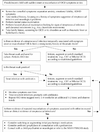Is obsessive-compulsive disorder an autoimmune disease?
- PMID: 11760984
- PMCID: PMC81631
Is obsessive-compulsive disorder an autoimmune disease?
Abstract
OBSESSIVE-COMPULSIVE DISORDER (OCD) IS A COMMON and debilitating neuropsychiatric disorder. Although it is widely believed to have a genetic basis, no specific genetic factors have been conclusively identified as yet, leading researchers to look for environmental risk factors that may interact with an underlying genetic susceptibility in affected individuals. Recently, there has been increasing interest in a possible link between streptococcal infections and the development of OCD and tic disorders in children. It has been suggested that OCD in some susceptible individuals may be caused by an autoimmune response to streptococcal infections, that is, a similar biological mechanism to that associated with Sydenham's chorea. The term "pediatric autoimmune neuropsychiatric disorders associated with streptococcal infections" (PANDAS) has been used to describe a subset of children with abrupt onset or exacerbations of OCD or tics, or both, following streptococcal infections. Affected children have relatively early symptom onset, characteristic comorbid symptoms and subtle neurological dysfunction. Neuroimaging studies reveal increased basal ganglia volumes, and the proposed cause involves the cross-reaction of streptococcal antibodies with basal ganglia tissue. Vulnerability to developing PANDAS probably involves genetic factors, and elevated levels of D8/17 antibodies may represent a marker of susceptibility to PANDAS. Prophylactic antibiotic treatments have thus far not been shown to be helpful in preventing symptom exacerbations. Intravenous immunoglobulin therapy may be an effective treatment in selected individuals. Further understanding of the role of streptococcal infections in childhood-onset OCD will be important in determining alternative and effective strategies for treatment, early identification and prevention of this common and debilitating psychiatric disorder.
Figures

Similar articles
-
PANDAS: current status and directions for research.Mol Psychiatry. 2004 Oct;9(10):900-7. doi: 10.1038/sj.mp.4001542. Mol Psychiatry. 2004. PMID: 15241433 Review.
-
[PANDAS: a possible model for adult OCD pathogenesis].Riv Psichiatr. 2009 Sep-Oct;44(5):285-98. Riv Psichiatr. 2009. PMID: 20066816 Review. Italian.
-
Paediatric autoimmune neuropsychiatric disorders associated with streptococcal infection (PANDAS).Int J Neuropsychopharmacol. 2001 Jun;4(2):191-8. doi: 10.1017/S1461145701002371. Int J Neuropsychopharmacol. 2001. PMID: 11466169
-
[Pediatric autoimmune neuropsychiatric disorders associated with streptococcal infections (PANDAS). A report of two cases].Psychiatr Pol. 2004 Jan-Feb;38(1):105-23. Psychiatr Pol. 2004. PMID: 15042736 Review. Polish.
-
Comparison of clinical characteristics of pediatric autoimmune neuropsychiatric disorders associated with streptococcal infections and childhood obsessive-compulsive disorder.J Child Adolesc Psychopharmacol. 2010 Aug;20(4):333-40. doi: 10.1089/cap.2010.0034. J Child Adolesc Psychopharmacol. 2010. PMID: 20807071 Free PMC article.
Cited by
-
Association between pediatric autoimmune neuropsychiatric disorders associated with streptococcal infections disease and tumor necrosis factor-α gene-308 g/a, -850 c/t polymorphisms in 4-12-year-old children in Adana/Turkey.Indian J Hum Genet. 2013 Apr;19(2):196-201. doi: 10.4103/0971-6866.116116. Indian J Hum Genet. 2013. PMID: 24019622 Free PMC article.
-
Tonsillectomy remains a questionable option for pediatric autoimmune neuropsychiatric disorders associated with streptococcal infections (PANDAS).GMS Curr Top Otorhinolaryngol Head Neck Surg. 2016 Dec 15;15:Doc07. doi: 10.3205/cto000134. eCollection 2016. GMS Curr Top Otorhinolaryngol Head Neck Surg. 2016. PMID: 28025607 Free PMC article. Review.
-
Obsessive-compulsive disorder in children and adolescents.Dtsch Arztebl Int. 2011 Mar;108(11):173-9. doi: 10.3238/arztebl.2011.0173. Epub 2011 Mar 18. Dtsch Arztebl Int. 2011. PMID: 21475565 Free PMC article. Review.
-
Autoantibodies in patients with obsessive-compulsive disorder: a systematic review.Transl Psychiatry. 2023 Jul 3;13(1):241. doi: 10.1038/s41398-023-02545-9. Transl Psychiatry. 2023. PMID: 37400462 Free PMC article.
-
Systemic autoimmune diseases are associated with an increased risk of obsessive-compulsive disorder: a nationwide population-based cohort study.Soc Psychiatry Psychiatr Epidemiol. 2019 Apr;54(4):507-516. doi: 10.1007/s00127-018-1622-y. Epub 2018 Nov 7. Soc Psychiatry Psychiatr Epidemiol. 2019. PMID: 30406283
References
-
- Geller DA, Biederman JS, Jones J, Shapiro S, Schwartz S, Park K. Obsessive-compulsive disorder in children and adolescents: a review. Harv Rev Psychiatry 1998; 5:260-73. - PubMed
-
- Rapoport JL. Obsessive-compulsive disorder and basal ganglia dysfunction. Psychol Med 1990;20:465-9. - PubMed
-
- Rapaport JL, Fiske A. The new biology of obsessive-compulsive disorder: implications for evolutionary psychology. Perspect Biol Med 1998;41(2):159-75. - PubMed
-
- Billett EA, Richter MA, Kennedy JL. Genetics of obsessive-compulsive disorder. In: Swinson RP, Antony MM, Rachman S, Richter MA, editors. Obsessive-compulsive disorder theory, research and treatment. New York: Guilford Press; 1998.
-
- Pauls DL, Alsobrook JP II. The inheritance of obsessive-compulsive disorder. Child Adolesc Psychiatr Clin N Am 1999;8(3):481-96. - PubMed
Publication types
MeSH terms
LinkOut - more resources
Full Text Sources
Medical
